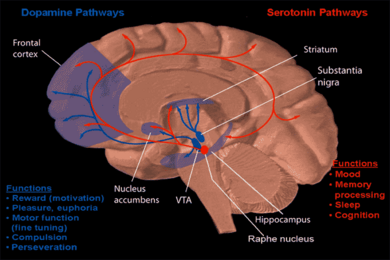Fundamentals of Neuroscience/Psychiatric Disorders
| Type classification: this is a lesson resource. |
| Subject Classification: this is a neuroscience resource. |
Goals
[edit | edit source]- To learn the characteristic symptoms of several common mental disorders
- To learn the role of neurological changes in generating psychiatric problems
- To learn about current and proposed treatments for these conditions' symptoms and causes
Anxiety Disorders
[edit | edit source]
As the name implies, anxiety disorders are a class of conditions that involve excessive and debilitating anxiety or panic and interfere with normal functioning. These conditions combined constitute the largest single source of mental illness. In addition to generalized anxiety (which is a chronic sense of anxiety not tied to a specific situation) and phobias (which are irrational fears of objects or situations not directly threatening), this group extends to other fairly common diagnoses including Obsessive compulsive disorder (OCD) and Post-traumatic stress disorder (PTSD). Patients with OCD are unable to break repetitive cycles of behavior or thoughts due to overwhelming urges fueled by irrational anxieties, such as fear of contamination or injury. PTSD largely affects individuals who have gone through a traumatic event that causes lingering feelings of fear or reliving of past traumas.
Although anxiety disorders encompass such a broad range of conditions, there are many important commonalities. All are closely linked to the stress response, and cause this system to be activated at inappropriate times- leading to misplaced feelings of intense fear, anxiety, or panic. The actual causes of many of these conditions are poorly understood, although in terms of the brain certain regions like the amygdala appear hyperactive or at least over-sensitive to stress hormones. In addition, lack of inhibitory neurotransmitters, such as GABA, can impair an individual's ability to cope with stress. Such brain changes can be caused by past experiences and associations (as is especially the case in PTSD), but generally anxieties like phobias have no relation to a specific history with the feared object.
Specific treatments for anxiety disorders can depend on the subtype in question, though many common treatments are employed to improve the symptoms- or even cure-an anxiety disorder. Since a lack of GABA enhances a patient's susceptibility to stress, drugs that mimic the action of GABA can ease the severity of anxiety a patient experiences. Another common approach to treatment is cognitive behavioral therapy, which attempts to expose a patient to anxiety-producing stimuli in situations which reinforce the message that any fear is irrational.
Depression
[edit | edit source]
Characterized by persistent feelings of intense sadness, hopelessness, and apathy, major depression is a common and debilitating disorder. Although occasional bouts of depressed mood are common for healthy individuals, what distinguishes depression is the intractability of these negative emotions and how it interferes with nearly all aspects of a patient's life. Individuals experiencing depression are often unable to experience pleasurable feelings, lose motivation for everyday tasks, and have feelings of guilt or despair so intense that thinking about anything else becomes difficult. Social withdrawal, insomnia, and contemplation of suicide are also common.
The biology of depression suggests that there are certain factors which can greatly elevate one's risk for depression, and it is the interaction of these factors with environmental circumstance that produces situations where some are able to avoid depression despite great adversity, others only experience depression after it is triggered by an acute tragic event, and still others face depression despite overall positive life experiences. Whatever its origins, depression tends to correlate with overproduction of stress hormones by the hypothalamus and underproduction of neurotransmitters like dopamine and serotonin which are essential for, among other things, reward pathways.
Depression can be managed in a variety of ways, and up to 80% of individuals are able to achieve a full recovery. Some of the most common pharmaceutical approaches are SSRI's (Selective Seretonin Reuptake Inhibitors), which improve mood by boosting levels of serotonin, which are found to be depleted in many patients with depression. psychological counseling can also be helpful for certain individuals. These programs vary in technique, but many attempt to improve a patient's life outlook and deal with negative emotional by looking at them rationally. For cases that fail to be treated using these methods, other options are available, such as electroconvulsive therapy
Schizophrenia
[edit | edit source]
Contrary to some popular misconceptions, schizophrenia is defined by an inability to distinguish reality from hallucination, disordered thought, and social impairment. These disturbances of the imagination are often so convincing and powerful that patients undergo severe personality changes and have higher cognitive functioning impaired- often having inappropriate or absent emotions, lack of motivation, and memory loss. Depending on the symptoms, schizophrenia can be classified into several types, ranging from occasional delusions or hallucinations but generally working mental faculties to complete disorganization of thought, emotion, and behavior. Hallucinations may affect any of the sense or a combination, may follow a common theme or be completely unconnected, or may be replaced by non-sensory delusions, which are entirely grounded in thought.
Schizophrenia has a fairly strong genetic component, although that is just one of a number of causes. Hypotheses for why schizophrenia emerges in some individuals but not others include an infection before birth, exposure to toxic substances, particularly drugs, and other disturbances of fetal development. Neurologically, there are some subtle but detectable differences in brains of people with schizophrenia. There is slight shrinkage in overall volume, and certain dopamine pathways also undergo chemical alterations.
Medications are available for addressing many of the symptoms of schizophrenia, although full recoveries are moderately rare. A class of drugs known as antipsychotics are usually effective against the hallucinatory symptoms, but many of the cognitive problems remain. Therapy is sometimes sought in conjunction with medication, although it is not very common despite promising results. Other antipsychotic medications are still being developed which are more effective at containing symptoms with less side effects.
